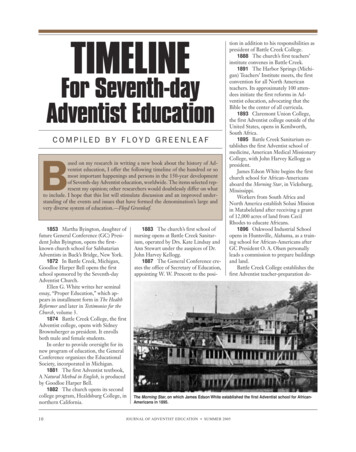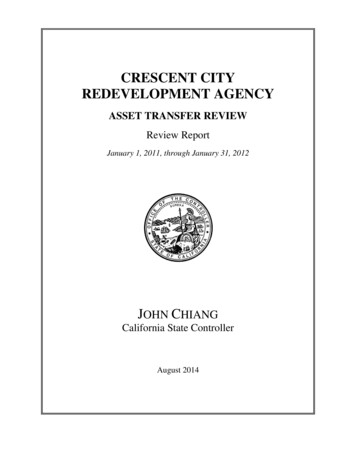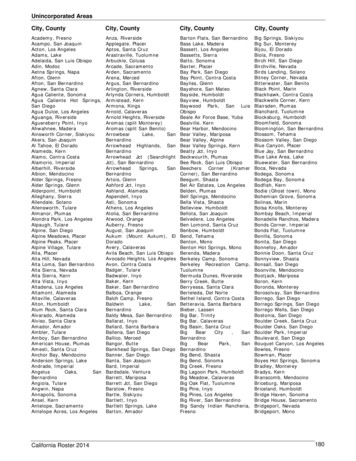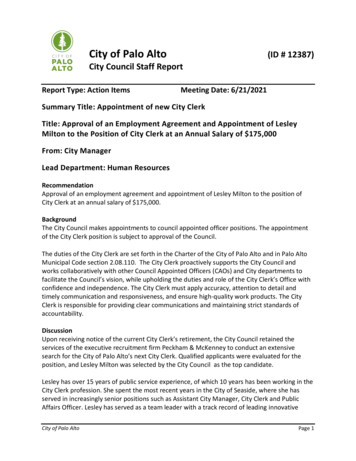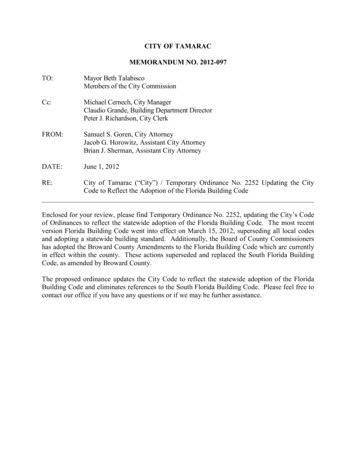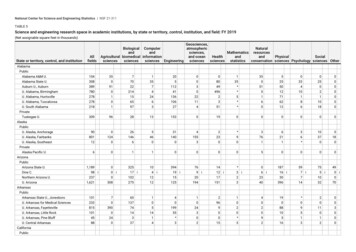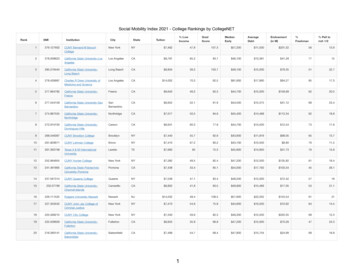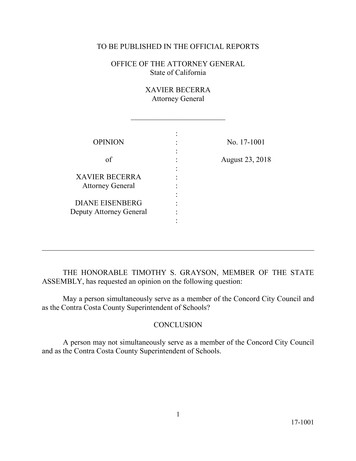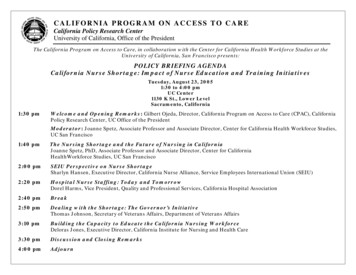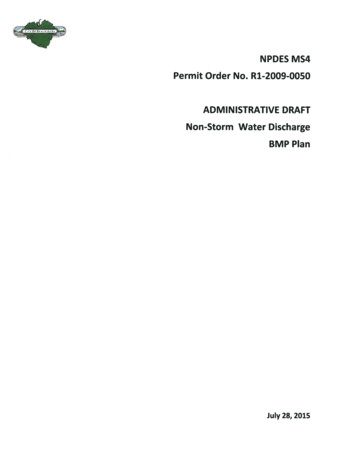
Transcription
WATER-BASED FIRE PROTECTIONSYSTEMS DISCHARGEBEST MANAGEMENT PRACTICES MANUALCalifornia State Fire MarshalIn cooperation withDivision of Water QualityStorm Water SectionSeptember 2011
Message from the Acting State Fire MarshalOn behalf of CAL FIRE – Office of the State Fire Marshal (OSFM) I ampleased to present the Water-Based Fire Protection Systems DischargeBest Management Practices Manual. The extensive discussions, analysis,and expertise resulting in these recommendations and best managementpractices (BMP) are essential to a balanced and appropriate approach for theproper processing of water discharged from a fire protection system. Thetesting and flushing of these life safety systems are important to thecontinued efforts to protect the citizens of California. The Task Force hopesthat these BMP will be embraced at both regional and local levels providing aconsistent application.The OSFM would like to extend a sincere gratitude to Co-Chairs: JamesParsegian; Deputy State Fire Marshal III, Fire Engineering Division, JamesCarver, Fire Marshal, El Segundo Fire Department, and Bruce Lecair, WestCoast Regional Manager, National Fire Sprinkler Association and to each ofthe members and organizations for their dedication and commitment to thisimportant project. We appreciate the participants’ willingness to share theirtime, energy, and talent; particularly during these very busy and difficultfiscal times. Through our partnerships we will continue to move fire andpanic safety initiatives forward, providing a safer working environment foremergency responders and a safer environment for all those who live inand/or visit the State of California.Sincerely,TONYA L. HOOVERActing State Fire MarshalWater-Based Fire Protection Systems DischargeBest Management Practices ManualPage 1
AcknowledgementsThis Best Management Practices Manual was developed through theaccumulation of research, analysis, and collaborative efforts of the manydisciplines involved with the State Fire Marshal Water Discharge for FireProtection Task Force.Included in those efforts are (in alphabetical order) the: Allan AutomaticSprinkler Corporation of Southern California, California State WaterResources Control Board, City of Beverly Hills Waste Water TreatmentProgram, City of El Segundo Fire Department, City of Healdsburg FireDepartment, City of Torrance Fire Department, East Bay Municipal UtilitiesDistrict, National Automatic Sprinkler Industry Promotion, National FireSprinkler Association, Northern California Fire Prevention OfficersAssociation, Paraclete Fire Safety Incorporated, Riverside County FireDepartment, Sonoma County Permit and Resource ManagementDepartment, and Southern California Fire Prevention Officers Association.Water Discharge for Fire Protection Task Force MembersJames Parsegian, Co-Chair, Office of the California State Fire MarshalJames Carver, Co-Chair, City of El Segundo Fire DepartmentBruce Lecair, Interim Co-Chair, National Fire Sprinkler AssociationAllen Quirk, Paraclete Fire Safety IncorporatedBill Hereth, California State Water Resources Control BoardBob Gebel, City of Torrance Fire DepartmentDavid Eugene Kimbrough, Castaic Lake Water AgencyJack Thacker, Allan Automatic Sprinkler Corporation of Southern CaliforniaJennifer Lorenzo, Office of the California State Fire MarshalJohn C. Dettle, City of Torrance Department of Public WorksJosette Descalzo, City of Beverly Hills Waste Water Treatment ProgramLinda Collister, City of Healdsburg Fire DepartmentRandy Collins, City of Healdsburg Fire DepartmentReg Cullen, Sonoma County Permit and Resource Management DepartmentRobert Livermore, TNT Fire ProtectionRon Stevenson, Allan Automatic Sprinkler Corp. of Southern CaliforniaSteve Hart, National Automatic Sprinkler Industry PromotionWalter Brandes, Riverside County Fire DepartmentWilliam R. Kirkpatrick, East Bay Municipal Utilities DistrictWater-Based Fire Protection Systems DischargeBest Management Practices ManualPage 2
Table of ContentsExecutive Summary . 4Overview . 4Purpose and Scope . 4Part 1: Participants . 5Part 2: Notification and Record Keeping . 6Part 3: Flow and Volume Determination . 8Part 4: Safety Considerations. 8Part 5: Discharge into Sensitive Areas . 9Part 6: Water Discharge Mitigation . 9Part 7: Water Discharge Awareness Course . 15Appendix A: Regional Water Quality Control Board Contact List . 17Appendix B: Typical Discharge Types and Volume Ranges . 19Appendix C: Record and Notification Forms . 28Appendix D: Pictures of Sediment Control Equipment . 30Appendix E: Awareness Course Outline . 33Glossary of Terms . 41Water-Based Fire Protection Systems DischargeBest Management Practices ManualPage 3
Executive SummaryIn response to a request by the National Fire Sprinkler Association, theState Fire Marshal convened a Water Discharge for Fire Protection TaskForce under the State Fire Marshal Automatic Extinguishing SystemsAdvisory Committee to review and develop a guideline for the dischargingwater from fire protection systems. The task force was established withrepresentatives from various agencies and organizations which includedboth government and industry. The purpose of the Task Force was todevelop a set of Best Management Practices for Contractors State LicenseBoard licensed contractors, State Fire Marshal licensed companies and thefire service; to discharge water from a fire protection systems and toprovide guidance regarding the practices to control possible contaminationof California waters when maintaining fire suppression systems.OverviewThis manual is intended to give persons discharging water (Discharger) froma water-based fire protection system and the municipal separate stormsewer system (MS4) operators a common set of best management practices(BMP) for the proper processing of water discharged from a fire protectionsystem.The types of discharge covered in this manual are associated with: Water-based fire protection system acceptance testing. Periodic water-based fire protection system testing and maintenance. Fire hydrant testing. Water-based fire protection system leaks and emergency repairs.Purpose and ScopeThe purpose of this document is to provide a set of BMP to affected partiesin the State of California with a range of procedures for mitigating thedischarge of water from a fire protection system to municipal storm sewersystems in a manner consistent with the protection of life property and theenvironment. It is not to provide a day-to-day field manual for dischargersbut rather a set of options (tools) from which dischargers and local agenciesmay select and customize for their particular needs and settings.Dischargers are encouraged to contact the operator of the receiving MS4system to discuss any specific discharge requirements.Water-Based Fire Protection Systems DischargeBest Management Practices ManualPage 4
Part 1: Participants1.Fire Departments are responsible for protecting life and property fromfire. Fire Departments periodically discharge water into the MS4.While emergency fire flows are exempted from permitting, nonemergency discharges may be regulated in some regions.2.MS4 are built, maintained, and/or operated by a wide range ofagencies such as municipalities, counties, flood control districts, androad/transportation departments. They must abide by and enforce theClean Water Act, the Porter-Cologne Act, and the Storm Water Rule.Most Regional Water Quality Control Boards (RWQCB) and the U.S.Environmental Protection Agency (EPA) issue MS4 permits; most MS4operators must have an MS4 permit. MS4 permits require agencies tolegally ban and prevent all illicit discharges of non-storm water fromentering their MS4. Water collected by MS4 is ultimately dischargedinto the waters of California.3.The State Water Resources Control Board (SWRCB) and the variousRWQCB are charged with the protection of the waters of California andenforcement of the Clean Water Act, the Porter-Cologne Act, and theStorm Water Rule.This is accomplished by the issuance andenforcement of National Pollution Discharge Elimination System(NPDES)/Waste Discharge Requirements (WDR) permits, includingMS4 permits for most MS4 operators and in some cases WDR forCommunity Water Systems (CWS) discharging into MS4.4.Dischargers include California State Fire Marshal (CSFM) SFM A licenseConcern, as well as Contractors State Licensing Board (CSLB) Type A,C-16, C-34, and C-36 licensees who perform testing and maintenanceof water-based fire protection systems as required by the CaliforniaFire Code. Carrying out these activities requires periodic andprescribed discharges into MS4. The activity and concerns/contactorsapproved for those activities are as follows.a. For water-based fire protection acceptance testing: Underground – Type A, C-16, C-34 and C-36 only Above Ground – C-16 only Water Flow – C-10 (limited to water flow only)b. For periodic water-based fire protection system testing andmaintenance: Underground – C-16 only Above Ground – C-16 only Water Flow – C-10 (limited to water flow only)Water-Based Fire Protection Systems DischargeBest Management Practices ManualPage 5
SFM A license Concern (Limited to testing andmaintenance)c. For fire hydrant testing: Underground – Type A, C-16, C-34 and C-36 only Above Ground – C-16 only SFM A license Concern (Limited to testing andmaintenance)d. For water-based fire protection system leaks and emergencyrepairs: Underground – Type A, C-16, C-34 and C-36 only Above Ground – C-16 only Water Flow – C-10 (limited to water flow only) SFM A license Concern (Limited to testing andmaintenance) Note: Fire Departments may conduct testing of any water based fireprotection system.Part 2: Notification and Record KeepingThis document covers discharges to the municipal storm sewer system, notthe sanitary sewer system. If it becomes necessary to discharge to thesanitary sewer system, written permission or a permit is typically requiredfrom the local sanitary sewer authority. When using this manual, a dischargeis water which comes from a single location and project. If a Dischargerreleases water from a given location and a given project in a series ofrelated events, these events are considered one discharge.1.Notification and Recordkeepinga. A single discharge of less than 1,500 gallons – Discharger doesnot need to give prior notification.b. A single discharge equal to or greater than 1,500 gallons but lessthan 10,000 gallons – Discharger does not need to give priornotification for any single discharge, but would need to maintainrecords of those discharges.c. A single discharge equal to or greater than 10,000 gallons –Discharger does need to give prior notification and maintainrecords of the discharge.2.Prior NotificationDischargers should notify the MS4 agency/operator not less than 24hours prior to any planned discharge and as soon as possible after anyemergency discharge. The method of notification must be by one ofthe four options listed below:Water-Based Fire Protection Systems DischargeBest Management Practices ManualPage 6
a.b.c.d.Telephone callA fax transmissionAn emailIn personNote: The large majority of single discharge events from existing building waterbased fire protection systems are drain and fill tests which are small in volume fallingat or below 1500 gallons based on building and system size. Reporting andrecordkeeping (though the latter is often done as a matter of practice by licensedDischargers) would yield a significant additional administrative and cost burden on allparties.3.RecordkeepingRecords should be kept utilizing the sample form provided inAppendix C of this manual. The sample form should be completed ineither black or blue ink. Records of discharges should be retained for aminimum of five years. Records must be made available for review bythe MS4 and/or RWQCB and must provide the following information:a. Information for all discharges greater than 1,500 gallonsb. Name of Dischargerc. Date of notification (if equal to or greater than 10,000 gallons)or emergencyd. Method of notification (if equal to or greater than 10,000gallons) or emergencye. Location of dischargef. Date of the dischargeg. Time of the beginning and end of the dischargeh. Duration of the discharge (minutes)i. Flow rate (gallons per minute)j. Total number of gallons dischargedk. Type of dechlorination “chemicals” usedl. Concentration of chlorine measured after dechlorination includingtime of sampling and description of sampling locationm. Type of sediment controls usedNote: When exact flows, volumes, and length of discharge are not available thedischarger needs to estimate the values.Water-Based Fire Protection Systems DischargeBest Management Practices ManualPage 7
FIRE SPRINKLERWATER DISCHARGE SUMMARYSediment andDebris ControlWithin PipingExteriorSystemSurfaceEvent TotalGallonsNotification MS4De-Chlorination 1,500Not RequiredNot RequiredNot Required 1,500 10,000Not Required* ****Not Required*******Required*******RequiredRequired if discharge is to enter storm drain system and water is fresh.Required if debris exists and together with discharge will enter storm drain systemRequired if it has been determined that chemical additives are within piping system.Part 3: Flow and Volume DeterminationDischargers need to determine the flow and volume of the discharge.1.Flow is determined by one of the following methods:a. Attaching a flow meter to the discharge opening and reading thedisplayed valueb. Measuring the pressure from a pressure gauge and then usingthe table or formulas found at the end of Appendix Bc. Where “a” or “b” are not applicable, measure the velocity (V)using a floating object and measure or calculate the crosssectional area (A) of flowing water. (V x A flow rate [e.g., V 2 ft/sec and A 1.5 ft2; Flow 3 ft3/sec or 1,347 gal/min])2.Volume is determined by multiplying the flow (e.g., gallons/minute)by the duration of the discharge (minutes).Part 4: Safety ConsiderationsDischargers need to take the following precautions before flow testing ahydrant:1.Ensure water will flow into nearby drain inlets as intended.Water-Based Fire Protection Systems DischargeBest Management Practices ManualPage 8
2.Ensure drain inlets are open and free of debris.3.Ensure flowing water will not cause flooding or damage to adjacentproperties.4.Ensure water flow trajectory willequipment, or pedestrian traffic.5.Ensure water flow does not create slick or unsafe conditions.notimpactnearbyvehicles,Note: Do not conduct the test if any unsafe condition exists or would be created. Ifin doubt, do not conduct the test and notify the building owner and MS4 operator ifprior notification was made.Part 5: Discharge into Sensitive AreasSensitive areas are those that may present a potential problem or hazard tothe environment. Use best judgment in analyzing each area. Address thefollowing concerns when evaluating whether to test the hydrant.1.Ensure road surfaces are free of debris that may flow into the draininlets or nearby sensitive areas.2.Ensure curbs or ditches are adequate to handle the flow withoutcreating a buildup of silt which cannot be contained and removed.3.Ensure water flows will be free of potential contaminants such as oil,contaminated soils, etc.4.Ensure water does not cause erosion.Note: Do not test the hydrant if any of the above or any other condition mayadversely impact the area. If in doubt, do not test and notify the building ownerand MS4 if prior notification was made. If a problem does arise, such as a majorerosion or siltation of nearby creeks, discontinue testing and notify the MS4immediately.Part 6: Water Discharge Mitigation1.Conduct flows for the shortest duration possible. MS4 may limitmaximum flow rate to storm sewer.2.Remove all debris from the curb and gutter before initiating flushing.Water-Based Fire Protection Systems DischargeBest Management Practices ManualPage 9
3.If chlorine residualmost, testing andresidual due to theintroduced duringdechlorination.is a concern, use dechlorination. Many, if notmaintenance discharges will not have chlorineage of the water in the system. If CWS water istesting and then discharged, it will require4.Whenever possible and when safe to do so without causing damage orerosion, contain flows onsite by directing the water to landscaped orgreen areas.5.When practicable and with the permission of the local sewer agency,divert sprinkler system discharge to the sewer. The local sewer agencymay have additional conditions.6.Assess the following prior to any partial or full discharge of water froma vault, substructure or building fire system into the street or stormdrain system.a. Ensure the water is not cloudy, discolored and/or has no unusualodor.b. Ensure the Fire Protection System water does not have chemicaladditives. If it has been determined that chemicals have beenadded to the fire protection system the following actions must betaken:Note: The following conditions may require testing by an accreditedlaboratory for cloudiness, discoloration and odors (sewage, chemicals,solvents, gasoline, etc.). Turbid water due to rust and musty stagnationwould be subject to BMP for containment and sediment control.i.ii.iii.7.The water should be tested by an approved testing facilityto determine the chemical and the proper treatment.Upon completion of the chemical report of the water test,the results should be submitted to the MS4 regulator todetermine the approved discharge method and location ofthe water discharge. Examples of the discharge locationmay be storm drains, sewage system or to an approvedtreatment facility or plant.If chemicals are to be reintroduced into a system, propersignage should be provided for guidance.Dechlorination – The MS4 General NPDES Permit requires all watersdischarged must be dechlorinated before entering a storm drain.Failure to follow this procedure could result in death of aquatic animalsand legal liability. Methods of dechlorinization include using aerationWater-Based Fire Protection Systems DischargeBest Management Practices ManualPage 10
and/or other appropriate means such as infiltration to the ground,bags, diffusers, and at sediment traps in drop inlets wherecontrollable.Dechlorination Equipmenta. Bags – Consisting of a mesh bag into which large tablets of drychemical are placed to react with residual chlorine to remove itfrom the waterb. Flow Meter (optional)c. Pressure Gauged. Pitot Tubee. Dechlorination chemicalsi.Sodium Sulfiteii. Sodium Bisulfateiii. Sodium Thiosulfateiv. Ascorbic Acidf. Diffusers – Mechanical devices which are placed on the end ofthe discharge point which automatically mixes the dischargedwater with either dry or wet dechlorination chemicals. A widevariety of diffusers are available.g. Chlorine Residual Test Kitsi.Test Strips – Are dipped into the water; the color of thestrip changes depending on the concentration of thechlorine. A comparator on the package allows for thedetermination of the chlorine concentration.ii. Color Wheels – A square clear plastic container that holdsabout 10 milliliters of water.Chemicals are added toproduce a pink color. A wheel attached to the plasticcontainer has different shades of pink which correspond todifferent concentrations of chlorine. The wheel can beturned so that the shade of pink of the water sample canbe matched to the corresponding chlorine concentration.iii. Electronic Colorimeters – Devices consisting of a glass orplastic cell and a hand-held electronic colorimeter.Asample of water is placed in the cell and chemicals areadded which produce a pink color. A second cell has awater sample with no chemicals added. The cell with nochemicals is placed into the colorimeter and the devicemeasures the intensity of color. This is then assigned avalue of zero. The cell that had chemicals added is thenplaced in the colorimeter and the device measures theintensity of the color and then converts that intensity intoa concentration of chlorine or chloramines on a display.Water-Based Fire Protection Systems DischargeBest Management Practices ManualPage 11
Note: Chlorine Residual Test Kits–In order to determine if thedechlorination process removes the disinfectant, it is necessary to testthe water.8.Sediment Control – The MS4 General NPDES Permit requires allDischargers to minimize sediments and other debris entering a stormdrain. Failure to follow this procedure could result in adverse impactsto aquatic animals, obstruction of flood control facilities, flooding, andlegal liability.a. There are a wide variety of equipment that may be used forsediment control and clean-up depending upon the requirementsof the specific site where discharges might occur (see AppendixD for pictures of examples).i.Wattlesii. Sand Bagsiii. Gravel bagsiv. Matsv. Boomsvi. Barricadesvii. Silt Fencingviii. Hay Balesix. Hosesx. Filtersxi. Debris Storagexii. Broomsxiii. Shovelsxiv. Rakesxv. Vacuum Truck or Wet/Dry Vacuumb. Procedure – As an example place gravel or sand filled bags toform dams across (perpendicular to) the flow path and curb withthe end of the dam (furthest from curb) curving slightlyupstream. Dam height, length, the number of bags used andthe interval between dams will vary depending upon siteconditions and the resources available. It is recognized thatthere will be some circumstances where steep topographyand/or high flow rates will preclude effective sediment removalusing any of the current technologies. The following criteriashould be used to determine bag placement:i.Dam Height – The height of each dam should be slightlyless than the height of the curb or other retaining structurethat is acting to channel the flow. If it is equal to or higherthan the curb, flow will be diverted onto the sidewalk andcause flooding.Water-Based Fire Protection Systems DischargeBest Management Practices ManualPage 12
ii.iii.iv.9.Dam Length – The longer the dam, the greater theponding area and the better the retention, which allowsthe sediment to drop out. However, dam length is limitedby the number of bags available, traffic flow considerationsand potential for flooding of property, bags and pondedwater should not extend outside of coned areas into trafficlanes or onto private property.Number of Dams and Distance between Dams – Ingeneral, the greater the number of dam locations betweenthe discharge source and entry into storm drains orreceiving waters, the greater the retention of sediment. Aminimum of two dams should be used in all cases. Theinterval between dams must shorten as the ground surfacegradient (slope) increases to maintain equivalent sedimentremoval rates.When the discharge is complete, allow any water that isponded behind the dams to be drained. Be sure stormdrain inlet is protected. Shovel up as much sediment aspossible. Move one of the dams to a location immediatelyupstream of the storm drain or to the point where the flowenters receiving waters to provide sediment control fordischarge cleanup. If possible, clean the flow path andupstream dams to remove residual sediment from thestreet. Retrieve all dam materials and store in appropriatelocation.Determine Flow PathDetermine the flow path of the discharge from the point of release tothe inlet of a storm drain.a. Procedures: Evaluate and determine the appropriate BMP to use.i.Isolate the riser or control valve prior to drainingii. Evaluate the release volume and character. Compare withthe release point and conveyanceb. Inspect the flow path to ensure the flow path is clear andunobstructed allowing water to flow to the storm drain. Considerthe following:i.The maximum flow rate that will not cause erosion orscouring of any exposed ground in the flow pathii. The flow path must offer adequate capacity to allow theflow to move quickly to the storm drain withoutundesirable flooding or pooling. There must be nothing inthe path that would interfere with the dechlorinationprocess or hinder the analysis of the chlorine level.Whether the flow path is paved or unpaved, permeable orWater-Based Fire Protection Systems DischargeBest Management Practices ManualPage 13
iii.impermeable, the flow must not inappropriately scour thesurface. The discharge must not damage either pavementor neighboring property or impact vehicle or pedestriantrafficPermeable and natural surfaces are much more subject toscouring and erosion and thus cannot support highervelocities and require more robust sediment controlequipment.If there are large areas of permeable or natural surfaceswhere scouring and mobilization of sediments are possible,hoses may be used to move the discharge point away fromthese areas to an area better able to support theanticipated flow or temporary mats or channels may beinstalled to protect the areac. Alignment of the discharge point can have importantimplications. Whether the discharge point is a diffuser or a hoseor a pipe, it must be placed in such a way that it does notundercut pavement or erode soils. The force with which thewater is hitting the surface should be minimized by adjusting theflow.i. Record the time of the beginning of the discharge.ii. Begin the flow slowly, increasing flow gradually so as notto damage any equipment or property.iii. Inspect the discharge path as the flow increases. Makesure that no scouring, erosion, or undercutting ofpavement is occurring. If concerns arise immediately takecorrective action which could include:1. Reduce the flow rate of the discharge.2. Adjust the angle of the discharge.3. Stop discharge altogether.d. Prepare the flow path for discharge. Remove materials that mayobstruct or divert discharge flow from the discharge point to theentrance. Also remove any materials that may interfere with thedechlorination process or clog the sediment control equipment.i.Place the dechlorination and sediment control equipmentbetween the point of release and the entry to the stormdrain.Impermeable and engineered surfaces cangenerally support higher velocities and require less robustsediment control equipment or angle of the discharge.ii.Add the dechlorination chemical to the equipment.iii.Measure the chlorine concentration at a point prior to theinlet to the storm drain. If chlorine residual is present,take steps to reduce this concentration, including but notlimited to:1. Make adjustments to the dechlorination equipmentWater-Based Fire Protection Systems DischargeBest Management Practices ManualPage 14
2.3.4.5.6.10.to increase the amount of chemical being added.Reduce the flow of the discharge.Add more chemical to the storage vessel.Reduce flow slowly and remove equipment.When the discharge is complete, record the time anddetermine the volume discharged.Clean up all debris and sediments in the flow pathand trapped by the control equipment.Drain Inlet Protection – Drain Inlet Filter BagBefore the drain event, check to be sure the fire protection systemdischarge does not interfere with or delay repairs or corrective actionsundertaken by the MS4 agency.a. Procedure: Evaluate and determine appropriate BMP to use.Place bags to either completely or partially surround drain inlet.The number of bags used will vary depending upon siteconditions and the resources available. Protection should beinstalled around all affected drain inlets within reason. Severalbags may need to be stacked on top of each other to producethe desired protection. Remove grate from drain inlet andensure that it is clear and clean of debris. Place filter bag insertso that edges are secured when grate is replaced. Periodicallyinspect and adjust bags. Because filter bags clog quickly, payparticular attention to water backing up around the drain inlet.Either replace the bags frequently or adjust upstream sedimentdams to provide more sediment removal prior to drain inlet.b. When the discharge is complete, allow any water that is pondedbehind the dams to drain. Clean the flow path and upstreamdams to remove residual sediment from the street. Retrieve allcontrol equipment and remove temporary drain inlet bag.Part 7: Water Discharge Awareness CourseThe CFSM developed a sample course outline for this BMP manual. This partpresents an overview of a joint effort to inform the water-based fireprotection system contractors, business concerns and the fire service ofthese guidelines and provisions. The outline is intended to assist dischargersin developing a training plan for their employees to ensure compliance withlocal, state and federal law dealing with the waters of California.1.The BMP outlined in this document are essential elements for acontractor and/or business concern to be aware of and to utilize in theday-to-day business company operations when discharging fireprotection system waters. The Awareness Level Training Course willhelp ensure that the procedures outlined in this set of BMP are utilizedWater-Based Fire Protection Systems DischargeBest Management Practices ManualPage 15
(see Appendix E).2.The Water Discharge for Fire Protection Systems Awareness LevelCourse will provide the student with:a. An awareness of the Water-Based Discharge for Fire ProtectionSystems BMP document and to become familiar with the wat
District, National Automatic Sprinkler Industry Promotion, National Fire Sprinkler Association, Northern California Fire Prevention Officers Association, Paraclete Fire Safety Incorporated, Riverside County Fire Department, Sonoma County Permit and Resource Management Department, and Southern California Fire Prevention Officers Association. Water Discharge for Fire Protection Task Force .
